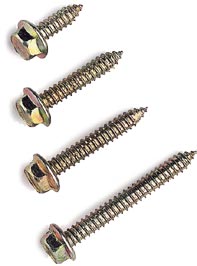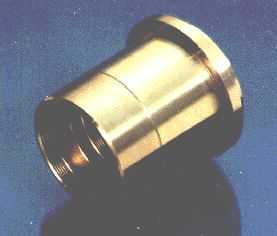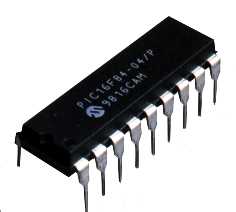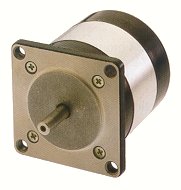Wealth Without Money/de
-- Main.AdrianBowyer - 24 Feb 2006
Hinweis: Dies wird eine Übersetzung des englischen Originals: Wealth_Without_Money
Reichtum ohne Geld
Der Hintergrund zum Bath Replicating Rapid Prototyper Projekt
Ein Druckkopf zum Extrudieren von niedrigschmelzender Metalllegierung, integriert in eine kommerzielle Rapid-Prototyping-Maschine. Er ist etwa 150mm hoch. Der Kopf wurde hergestellt, um einen neuen Rapid-Prototyping (RP) Prozess zu demonstrieren, den wir für die direkte Integration von elektrischen Leitern in Rapid-Prototypes entwickelt haben, und um diese Integration tatsächlich durchzuführen.
Karl Marx und Frederick Engels schrieben im Kommunistischen Manifest, dass "Mit Proletariat ist die Klasse der modernen Lohnarbeiter gemeint, die, da sie keine eigenen Produktionsmittel besitzen, darauf angewiesen sind, ihre Arbeitskraft zu verkaufen, um leben zu können." Diese Diagnose ist im Wesentlichen korrekt; es ist ein Allgemeinplatz, dass Menschen mit Ressourcen diese recht einfach nutzen können, um mehr zu erlangen, aber Menschen ohne sie müssen sich außergewöhnlich schwer anstrengen, um irgendetwas zu erreichen, und die meisten von ihnen schaffen es nie. Der Marxismus fährt dann fort und sagt, dass der Weg zur Lösung dieses Problems darin besteht, dass das Proletariat sich die Produktionsmittel durch eine Revolution aneignet, was ein guter Kandidat für die schlimmste Idee in der gesamten menschlichen Geschichte ist. Wann immer sie angewandt wird, sind die am meisten Produzierten Dinge Leichen, und in den letzten hundert Jahren war die Leichenzahl aufgrund der Anwendung dieser Idee noch schlimmer als die des Nazismus. Somit ist das Rezept des Marxismus', anders als seine Diagnose, völlig falsch. Auch seine Prognose erweist sich als falsch - er sagte voraus, dass die Revolution als erstes in den am meisten industrialisierten Nationen stattfinden würde (damals Britannien), wohingegen marxistische Revolutionen in der Praxis eher in Ländern geschehen, die den Übergang von einer landwirtschaftlichen Wirtschaft zu einer industriellen Wirtschaft durchmachen.
Als erreichte Marx 33% Treffer - nicht sehr gut. Aber behalten Sie seine korrekte Diagnose im Kopf, und lesen Sie weiter.
In der Mitte des 20. Jahrhunderts schlug John von Neumann einen Universal Constructor [1] vor - eine Maschine, die sich selbst kopieren kann. Seitdem hat eine Anzahl von Leuten seine Idee umgesetzt, sowohl als Simulation, als auch als reale Maschine. Aber im Fall der realen Maschinen erfordern alle aktuellen Systeme eine Zufuhr sehr komplizierter und komplexer Bausteine. Der Zweck dieser kurzen Webseite ist, Sie zu überzeugen, dass es eine Entwicklung in der Direktdruck- und Rapid-Prototyping-Technologie gibt, die nicht nur die Wichtigste ist, sondern die wichtiger ist als alle anderen zusammen. Diese Entwicklung wäre eine Direktdruck oder Rapid-Prototyping-Maschine, die eine Kopie von sich selbst machen kann. Ich behaupte, dass dies die erste nützliche Version eines Universellen Konstruktors nach von Neumann ist, den wir haben kann. Hier meine ich mit "nützlich", dass sie tatsächlich Zeug herstellen kann, das wir wollen. Während ich davon erzähle, was ich meine, und bevor ich argumentiere, warum dies so wichtig ist, lassen Sie mich sagen, was genau ich mit "eine Kopie von sich selbst machen" meine. Ich meine eine Rapid-Prototyping-Maschine, die alle ihre Komponenten herstellen kann, außer:
| Selbstschneidende Stahlschrauben, | Messinglager, |
| Schmierfett, | Standard-Elektronik-Chips wie Mikrocontroller und optische Sensoren, |
| Ein Standard-Niederspannungs-Netzteil und | Schrittmotoren. |
This list is an attempt to make a compromise between immediately-achievable technology and the desirable aim of shortening or eliminating it altogether. Note that it implies a machine that is capable of building three-dimensional objects from both an electrically insulating material and a conductor, like our deposition head in the picture. After the components have been made, it is quite acceptable for a person to assemble the machine from those components and the standard parts listed above, and to copy the firmware from the parent machine's microcontroller into that of the child.
The original idea of a Universal Constructor was of a machine that would both self-copy and self-assemble - as a bacterium or a daffodil do. The machine I propose will self-copy, but not self-assemble. In nature all four possibilities exist: things that neither self-copy nor self-assemble, like rocks; things that self-copy but don't self-assemble, like viruses; things that self-assemble but don't self-copy, like proteins; and finally things that both self-copy and self-assemble, like you and me. And you and I are quite dexterous at assembling machines that we want (even if we do swear at flat-pack furniture), so the second alternative (self-copying without self-assembly) is economically and practically the most interesting option. This web-page, therefore, is about making a useful virus that is as big as a fridge...
It would also be useful (though not initially essential) if the machine could grow itself by making appropriate components to extend its own movement axes, and could self-calibrate (possibly using an accurate reference object or a pattern of standard size) so that child machines would make products as accurately as their parent machine.
Die drei wichtigsten Aspekte solch einer selbstkopierenden Rapid-Prototyping-Maschine sind, dass:
- 1. die Anzahl der existierenden Maschinen und der Reichtum, den sie produzieren können, exponentiell wächst,
- 2. die Maschine der Evolution durch künstliche Auslese unterworfen wird, und
- 3. die Maschine Reichtum mit einem minimalen Bedarf für industrielle Fertigung erschafft.
Lassen Sie uns diese drei Aussagen detaillierter untersuchen.
Firstly, and most obviously, exponential growth: all current engineering production generates goods in an arithmetic progression. Sometimes this is very fast; suppose an injection moulding machine makes plastic combs at the rate of 10,000 an hour. Suppose further that a self-copying rapid-prototyping machine can make one copy of itself a day, and also just one comb. After merely 18 days, the rapid-prototyping machines will be making more combs than the injection moulder, assuming people give them house-room. Self-copying rapid-prototyping machines can multiply exponentially and so can the goods they produce. No technology other than self-copying can do this, and exponential production growth is the fastest that is mathematically possible (which is why all living organisms use it). At one machine per day, after one month there would be a machine for every man, woman, and child on the planet. Raw materials might be a bit of a bottle-neck, of course...
Secondly, evolution: for the machine to be able to copy itself, its own CAD design needs to be available along with it, for example on a copyable CD. People may just have their machine copy itself, or they may improve the design (and its firmware) and have their existing parent machine make their new, and better, child machines instead. That's how we made a labrador out of a wolf. Thus the machines will improve; good designs will come to predominate, and the lesser ones will fall by the wayside. This is almost the same as Darwinian evolution, but with one important difference: in nature, mutations are random, and only a tiny fraction are improvements; but with self-copying rapid-prototyping machines, every mutation is a product of analytical thought. This means that the rate of improvement should be very rapid, at least at the start. It also means that the initial design does not need to be very good, as long as it's capable of making a copy of itself and producing some other useful objects. Evolution can be relied on to make very good designs emerge quickly. It will also gradually eliminate items from my initial list of parts that need to be externally supplied. Finally here, note that any old not-so-good machine can still make a new machine to the latest and best design.
Thirdly, the minimal need for industrial manufacturing: it does not matter how much the first machine costs, the second will only cost as much as its raw materials and its assembly. And so will all subsequent machines. A company (or an individual) who acquires one machine can thereby have any number they want. This could turn rapid prototyping from a development into a production technology. It also means that people of modest means will be able to own them, and also let their friends have copies. They will be able to make themselves a new flute, a new digital camera, or just a new comb by downloading the designs for them from the Web. Some of the designs will be sold; some will be available free. Industrial production may be needed for the raw materials in considerable quantities, and will be subject to the normal market forces that keep the price of non-innovative standard products low. (Note that strategies such as those used by printer manufacturers to keep the price of consumable inkjet cartridges artificially high - having unique protected designs, and incorporating counter chips to prevent refilling - will not work with the raw materials for self-copying rapid-prototyping machines because people will simply re-design the machines to bypass such artificial restrictions on the materials they consume.) However, there is also another route to the creation of raw materials, and that is to use polymers like polylactic acid that can be made by fermentation from biomass. Thus a person with a few tens of square meters of land on which to grow a starch-crop (like maize) could make their own polymer (the machine being able to make the fermenter, of course). Then not only would the machine be self-replicating, the material supply would be too. In addition, it would even take CO2 out of the atmosphere and lock it away in plastic goods, though polylactic acid is biodegradable.
- - o - -
Ich brauche kein Ersatzteil für meinen kaputten Staubsauger zu kaufen, wenn ich eins aus dem Internet herunterladen kann; ich kann nämlich sogar den ganzen Staubsager herunterladen. Auch brauche ich keinen Laden und keinen Internet-Bestelllager, um mir diese Dinge zu liefern. Ich muss bloß Standardteile und -materialien im Supermarkt neben meinen wöchentlichen Einkäufen kaufen können.
Die selbstkopierende Rapid-Prototyping-Maschine wird den Menschen ermöglichen, für sich selbst viele der Dinge herzustellen, die sie wollen, einschließlich der Maschine, die die Herstellung durchführt. Es ist die erste Technologie, die wir haben können, die die Menschen gleichzeitig reicher macht, während sie gleichzeitig die Notwendigkeit für industrielle Produktion verringert.
Wenn jedoch alle eine Reichtumsmaschine auf ihrem Dachboden haben, werden Sie Dinge aus einer Laune heraus machen, und die meisten dieser Dinge werden Ramsch sein. Auch wird es keine wirkliche Notwendigkeit geben, Dinge langlebig zu machen - wenn etwas kaputtgeht, werden die Leute einfach ein anderes machen. Bald werden wir alle knietief in kaputten oder ungewollten Konsumgütern stehen, und diese werden effizient zu Rohmaterial recycelt werden müssen. Ursprünglich dachte ich, dass dieses Recycling, zusammen mit der Herstellung und Verbreitung von Baumaterialien, eine große industrielle Marktlücke sein würde. Dann habe ich begriffen, dass jede Maschine ihren eigenen kleinen Recycler machen kann - sie kann essen.
- - o - -
So the replicating rapid prototyping machine will allow the revolutionary ownership, by the proletariat, of the means of production. But it will do so without all that messy and dangerous revolution stuff, and even without all that messy and dangerous industrial stuff. Therefore I have decided to call this process Darwinian Marxism...
Adrian Bowyer 2. Februar 2004; aktualisiert: 21. Juni 2005, 1. Dezember 2005, 24. Februar 2006, 18. März 2007




